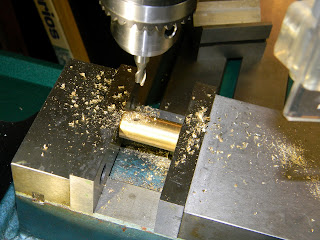Started by cutting about a third of the threads off the front half of the valve. An untouched half is on top... This increases CO2 volume inside the valve.
A 1/4" diameter end mill was used next.
Again, this increases volume. Obviously, the modified valve front is on the left.
Chucked a tiny ball mill in the Dremel.
This is the rear half of the valve. Relieved the sharp ninety degree corner at the bottom of the transfer port. The goal is to smooth out and radius the edge.
Cut a counter bore on top of the transfer port.
...and a similar counter bore in the breech end of the barrel.
Replaced the stock valve spring with something much softer.
Probably unnecessary, but the valve body threads got some teflon tape.
Since the valve gained so much additional volume, safety concerns dictate beefing up the valve securement in the gas tube. Beats having the valve become a potential missile. The red tape was used to help with layout for two additional valve screws.
I've done almost these very same steps during the AirSource project here.
Set-up was a bit different due to the use of the 2260 gas tube. A jack screw held up the off end.
Spotted and drilled with a #29 drill bit, followed up with a 1/4" to counter bore for the screw heads.
Tapped the holes #8-32.
Turned down some #8-32 socket head cap screws to 0.248".
The socket heads stick out a wee bit.
Just enough to be too much.
Faced 'em down in the lathe and rounded the heads over with a file. I'll blue these later.
With the counter bores cut for the transfer port, the stock transfer port tube was too short. I cut and faced a short piece of 0.250" diameter brass tubing.
The initial idea was to use a small o-ring at each end of the tube to effect a seal.
Like so.
Tube gets sandwiched between the o-rings. Well, it will once the breech is installed. (There's one of the blued screws)
And here's the o-ring mate in the breech. In practice, this didn't work very well. Ended up changing from o-rings to thin discs cut from 0.250" diameter vinyl tubing. The tubing was stiffer and didn't collapse as much as the o-rings. Sorry, no pics of the vinyl. Maybe later.

And here's where this whole experiment goes both right--and wrong. The gun hits 600 fps with a .22 cal RWS Hobby pellet--that's 150 fps faster than a stock 2240. Some of the gain is no doubt simply due to the 13.5" barrel length--about 6" longer than a stock Crosman 2240. The wrong part is the absurd usage of CO2. The shot count went down to around 8 or 9 shots. I forget exactly just how many because I was too busy changing cartridges to actually keep track. Crosman can barely fill them as fast as this gun can empty them. I can't live with the low shot count, so I've changed the front half of the valve and valve spring back to stock. The gun with a slightly stiffer hammer spring is now putting out 550 fps and getting about 25+ decent shots before it drops below a useful (to me) velocity.
More in a few days.
























1 comment:
Maybe you could convert this gun to bulk fill? Judging by your past work, I have no doubt you could.
Post a Comment